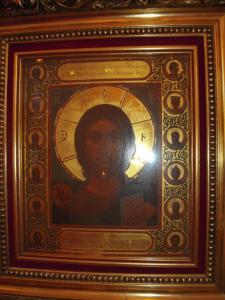Blessed Ecclesiastical New Year.

Christ Pantocrator. From the frescoes of the Cathedral of St. Sophia (the Holy Wisdom of God) in Veliky Novgorod. Icon 20th century. Saint John the Baptist Russo-Orthodox church in Chipman, Lamont, Alberta, Canada.
According to legend, the painters painted the large Christ Pantocrator in the dome with a clenched fist. The archbishop told them to repaint Christ with an open palm, and when they returned the next morning, the hand was miraculously clenched again. After repeated efforts, a voice from the dome is said to have told the archbishop to leave the painting alone for as long as Christ’s fist remained closed, he would hold the fate of Novgorod in his hand.
Monday, September 14 (the Julian calendar: September 1), marks the beginning of the Ecclesiastical New Year, when the cycle of liturgical commemorations begins anew. The existence of this separate New Year’s commemoration, distinct from the civil New Year on January 1, serves as a reminder both to Christians and to the World. The Church, it proclaims, is not bound to the institutions of this world, but rather stands apart from them. The Church, existing in the world but never being of the World, celebrates according to its own calendar and its own traditions, and not according to the World’s schedule.
It is, thus, fitting, that on this same day the Church commemorates Saint Symeon the Stylite, a fifth-century ascetic who confounded the World by setting up his hermitage on top of a pillar in the middle of the market in Aleppo. By publicly living a vigorously Christian life, separate from the worldly conception of success and prosperity, Saint Symeon gave powerful witness to the Gospel, especially of the command “If any man will come after Me, let him deny himself, and take up his cross, and follow Me” (Matt. 16:24).
May this coming year bring boundless opportunities to bear witness to the truth of the Gospel in our increasingly anti-Christian and worldly society. Let us also resolve, with God’s aid, to increase our personal spiritual striving, in prayer, fasting, and repentance.
The Blessings of the Lord, through His Grace and the Love toward mankind be upon you all always, now and ever, and unto ages of ages. Amen.




 Save as PDF
Save as PDF